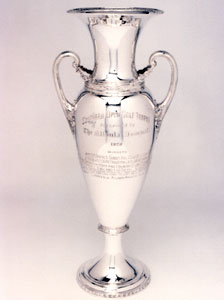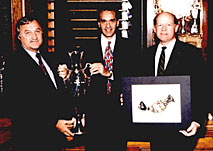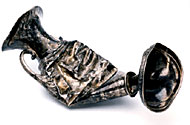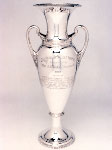

| Home | Restoration | FAQs | About Us | Customer Service |
Custom Design |
Silver Care | Silver 101 |
Silver Sales | ||||||||||



75 Year Old Southern Open Trophy
In 1927 the Southern Open Golf Trophy was in the hands of Bobby T. Jones, in 1979 it was in the hands of thieves, and in 1996, following its restoration by Estes-Simmons Silverplating of Atlanta, it was placed in the hands of the original owners, the Atlanta Athletic Club.
 The sterling silver trophy, which is 24" high and weighs 113
troy ounces (10 lbs.) was originally manufactured by Bailey, Banks
and Biddle in 1919 and presented to the winners of the Southern Open
Golf Tournament from 1919 through 1927. Engraved on the trophy are
the names of the winners: James Barnes - 1919, Douglas Edgar - 1920,
Gene Sarazan - 1922, Bobby Jones - 1927, and the tournament sponsor,
The Atlanta Journal.
The sterling silver trophy, which is 24" high and weighs 113
troy ounces (10 lbs.) was originally manufactured by Bailey, Banks
and Biddle in 1919 and presented to the winners of the Southern Open
Golf Tournament from 1919 through 1927. Engraved on the trophy are
the names of the winners: James Barnes - 1919, Douglas Edgar - 1920,
Gene Sarazan - 1922, Bobby Jones - 1927, and the tournament sponsor,
The Atlanta Journal.
The trophy, now a piece of American golf history, was placed
on display in 1975 at the Atlanta Athletic Club. With silver prices
skyrocketing, the value of the trophy increased and the trophy was
ultimately stolen. When it was recovered, one year later, the trophy
was barely recognizable. The thieves had crushed the trophy in hopes
of melting it down for its scrap metal value. Although other silver
experts declined restoring this piece of history, it was not until
Estes-Simmons was called upon that actual restoration began.
 Step 1
Step 1
"
The initial stages of restoration required a great deal of planning," said
Mark Antebi, owner of Estes-Simmons Silverplating. Along with his master
silversmiths, Mark studied the trophy to determine how it was manufactured. "We
had to determine how it was made and where it was put together to be
able to get inside the trophy," said Mark. "To repair an
item, you must apply Newton's Law - for every action there has to be
an equal and opposite reaction. "
Maintaining the authenticity of the trophy was of major concern to the craftsmen at Estes-Simmons. It was important to retain as much of the original engraving as possible. Before any restoration could be done, the original engraving had to be transcribed so that it could be retraced later. Using magnifying glasses and loops, silversmiths outlined the engraving, determining line length, letter height, and engraving styles. Having completed that step, restoration began.
Step 2
The trophy was disassembled into three integral parts: at the
top, mid section and the bottom. The bands of decoration on the top,
the handles and the garland had to be removed by heating each section
and gently easing the applied piece off.
Once the individual pieces were disassembled, they had to be reshaped into their true forms. The hammering process used to reshape the trophy to its original form involved several steps. First, highly polished steel forms in a variety of shapes, known as "stakes," were placed onto a heavy duty vice. Next, the sliver piece being reshaped was placed on the form. Using highly polished/mirror finished silversmith hammers of different shapes and sizes, the silversmith began to strike the damaged area with tiny blows, being careful not to mat, flatten, or stretch the silver. Using a circular rotation, small portions of the damaged area were hammered, shaped and then annealed (heated and cooled to reduce brittleness) before moving onto another section. Over 200 blows were struck per rotation. More than 20 rotations were completed on the midsection only.
When the true shape of the top and bottom were achieved, it was time to begin restoring the midsection. Before any work could be done, "Alligator Jaws" were used to spread the midsection apart. Using the hammering process described, the midsection was hammered back to its true shape, carefully working around the engraving to avoid further marring or additional loss of clarity. Over one half-million hammer strikes were needed to get the piece back into shape.
 Step 3
Step 3
The next step was to cast the missing pieces of the garland and
decorative band from the existing pieces. The three main sections
were then buffed with a medium abrasive wheel and assembled with
silver solder, making sure to reproduce the proper angles to insure
that the trophy would not lean. Custom made high purity silver solder
was used to eliminate yellow discoloration left by other less pure
silver solders. All the parts were buffed again with a medium to
fine wheel. At that time the garland, handles and other decorative
pieces were soldered into place. The soldered joints and areas that
had been blurred by the damage or the restoration were then chased
to replace clarity and detail.
To complete the restoration, the engraving was retraced by a master engraver, clarifying the blurred areas and saving 95% of the original outlines. The final polishing was accomplished with a cotton flannel buff and jeweler's rouge. This step restored the luster and finish. It took approximately 100 man hours to restore the trophy.
"Restoring this trophy resulted in a moment of true pride and joy," said Mark. "The ultimate reward was the reaction of the Atlanta Athletic Club's board of directors when the trophy was returned to its place of honor."